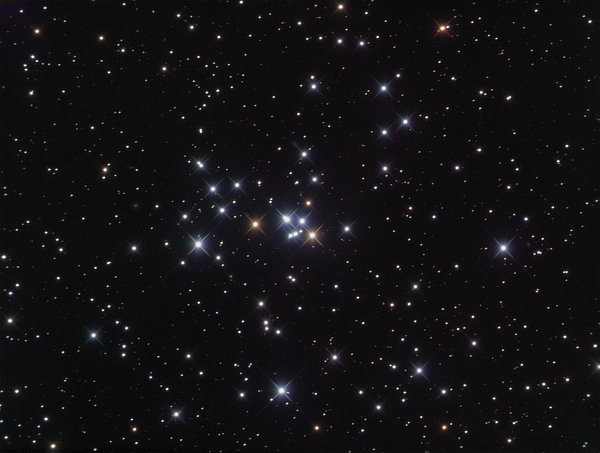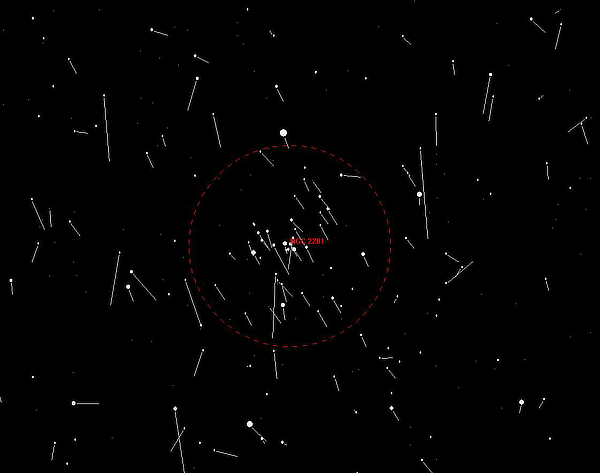NGC 2281 in Auriga
January 2024 - Nebula and Cluster of the Month
Let me start by wishing you all a very happy new year. Let’s hope for dark, clear skies and a complete ban on unnecessary outside lighting. You may say I’m a dreamer, but I’m not the only one.
As the new year opens, we’re going to look at a modest but pleasing little open cluster in Auriga. It culminates at midnight on the 5th January, when it is at an altitude of 77° from mid-Britain.
Like so many of the objects featured in this column, it was discovered by William Herschel. Herschel discovered over 2,500 deep-sky objects, and naturally, these tend to be the brightest and most easily distinguishable. Hence so many of the objects we look at are his discoveries.
He first saw this cluster on 4th March 1788. At that time, Herschel described it as A cluster of coarsely scattered, pretty large stars. Pretty rich.
He placed it in his class VIII, ‘Coarsely scattered clusters of stars’ as no. 71.

A study1 was made of the cluster during 2020, during which the distance from Earth was calculated as 500—560 parsecs (1630—1830 light-years) and its age as 630 million years.
The study also identified an eclipsing binary star, GSC 2945-01857. This (generally) 12.3 magnitude star lies 17’ from the centre of the cluster, and the authors of the paper admit that the probability of this star actually being a member of the cluster is only 18%, statistically speaking.
NGC 2281 lies in a patch of sky rather barren of bright stars. It forms an isosceles triangle with and to the east of β and θ Aurigae, magnitudes 1.9 and 2.6 respectively, and sits amid the scattering of stars that all bear the designation ψ Aurigae. Specifically, the cluster is just about quarter of the way between ψ7 and ψ3. These two stars are magnitudes 5.0 and 5.3.
Most authorities agree that the combined magnitude of the cluster is 5.4, and generally concur that the Trumpler classification should be I3m (well detached, range of bright and faint stars, moderately rich (50—100 stars), though The Night Sky Observer’s Guide assigns it a ‘poor’ richness rating (fewer than 50 stars).
Uranometria and The Night Sky Observer’s Guide both assign the cluster 30 member stars, of which the brightest is magnitude 7.3, whereas Star Clusters by Archinal and Hynes give it 119 members, the brightest of which is given a magnitude of 8.0.
Estimates of its angular size on the sky also vary, with Uranometria and The Night Sky Observer’s Guide giving 14’ whilst Archinal and Hynes nearly double that at 25’.
It’s always worth checking the proper motions of stars in and around open clusters. This can give a much clearer insight into how large the cluster is and, indeed, whether it is a true cluster or simply a coincidental line-of-sight arrangement.
The proper motions around NGC 2281 (below) show clearly that this is a true cluster of gravitationally-bound stars and that the bounds of the cluster lie well outside that marked on the chart.

Visually, NGC 2281 is bright and despite the lack of bright signpost stars, is simple enough to find. At magnitude 5.4, it should be easily visible in a finder scope.
Moderate telescopes (8”—16” aperture) will reveal two to three dozen stars, the brightest four clumping at the centre.
I made a written observation of NGC 2281 in November 2013 with my 12” (300mm) Newtonian. The description in my records reads A pretty little cluster maybe 15’ across. There seem to be two dozen members or so. It looks like a cavorting fish with the snout pointing north and the thrashing tail pointing east. The brightest stars (9m) form a rhomboid at the junction of the body and the tail. The stars of the body are about mag. 10.
Although I didn’t make a drawing of the cluster at the time, it has remained quite vivid in my memory because of this fish-like appearance.
Have a look. See if you can see the fish.
| Object | RA | Dec | Type | Magnitude |
|---|---|---|---|---|
| NGC 2281 | 06h 48m 20s | +41° 04’ 48” | Open cluster | 5.4 |
References:
- Terrell D, Gross J, Cooney WR Jr. Analysis of the Open Cluster NGC 2281. Galaxies. 2021; 9(1):7. https://doi.org/10.3390/galaxies9010007